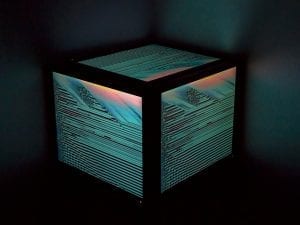The Aesthetica Art Prize is an international celebration of innovation and brilliance in contemporary art. Offering entrants an opportunity to showcase their work to a wider audience, previous finalists have included Julia Vogl (Winner of the Catlin Art Prize 2012 and shortlisted for Saatchi Gallery and Channel 4’s New Sensations), Marcus Jansen (leading modern expressionist who joined a legacy of artists by featuring in Absolut Vodka’s artistic campaigns) and Bernat Millet (shortlisted for the National Portrait Gallery’s Taylor Wessing Photographic Portrait Prize.) The prize is comprised of four categories: photographic & digital art, three dimensional design & sculpture, painting & drawing video and installation & performance. The long-listed artists are featured in the accompanying Art Prize publication, while the short-listed artists appear in an exhibition at York St Mary’s, York. We catch up with long-listed emerging Korean-American artist, Timothy Lee. Raised in New York City and having studied Neuroscience & Behavior, Studio Art (Drawing), and Biology (Developmental) at Wesleyan University, his artistic practices have been heavily influenced by the imagery of cytology and his research in a neural stem cell laboratory as an undergraduate student.
A: You work with paint, how do you find this medium is suitable to express your artistic vision?
TL: I primarily use watercolor for many of my artworks, and I find that this medium is particularly suited for my working process. Because I have a tendency to “tighten up” over trivial details on my artwork, using watercolor – which is considered a very unforgiving medium – allows me to prioritize what is most important in making my pieces. In addition, the fluidity of watercolor, and the fact that I can apply multiple washes that overlap with each other, is the perfect complement to the systematic way in which I approach my pieces.
A: Do you work with any other artistic forms?
TL: I consider myself a multimedia artist, meaning that I try to constantly explore other artistic forms and experiment with merging various mediums together. In many of my past pieces, I have combined sculpture with watercolor paintings and created large installations with them, taking advantage of the materiality of my paper as both a surface to work on, but as a sculptural element as well. I am beginning to really enjoy the realm of sculpture, in particular because there are no limitations to size, and even more so because there are no edges that I have to keep in mind (which is something that challenges me when working two-dimensionally).
A: How does you feel to be part of the Aesthetica Art Prize?
TL: It is truly an amazing honor to be long-listed for the Aesthetica Art Prize! As a recent college graduate, and an emerging artist, being selected as part of such a prestigious award is a true indication for me that selecting the path of art was the right choice. Up until my senior year of college, I was certain that my fate was to enter medicine (I had even taken my MCATs – yikes!) but ultimately, the passion I felt when embarking on my senior art thesis at Wesleyan University was a wake up call for me that I should reconsider my future. I have been looking up the artworks of the other artists long-listed for the Aesthetica Art Prize, and I am really in awe by the amazing diversity of works that were chosen.
A: Which artists have inspired you?
TL: So many artists have had a huge influence on the artworks that I have produced. My piece 308.3 strongly resonates with the meticulous works of Yayoi Kusama, whereas I have also been looking at artists such as Jenny Saville, Wayne Thiebaud, and even the Renaissance painter Titian, to inform my techniques in oil painting. I have also recently been researching Korean art, both traditional and contemporary, to understand the current direction the art scene there is headed towards. My working process has been tremendously influenced by three professors at Wesleyan: Jeffrey Schiff, David Schorr, and Julia Randall. Julia Randall, in particular, was my thesis advisor during my senior year at Wesleyan, and working closely under her and seeing the artworks that she also made was a great stepping stone in understanding what I was most interested in making works about.
A: What do you have planned for the future?
TL: I am currently working as an art instructor at Oogie Art Academy, which is a magnet art program for high school students located in New York City. I love teaching, and eventually would like to teach at a university level while still having the time to make artworks. But until then, I am living life to the fullest and enjoying my professions as an educator and an artist.
A: What is the starting point for one of your works?
TL: Usually, the starting point for me in any drawing is to break down my subject into the largest and simplest geometric shapes possible, and use those shapes to plan out the composition of my drawings. I think it’s very important to work from large and vague, to small and detailed, when doing any drawing so that you are constantly understanding and establishing relationships between the subjects/objects as well as with their environment (foreground, mid-ground and background). However, in my most recent series of works, I forgo that entire process and start working at an arbitrary spot on my paper – none of my pieces have a premeditated composition, and the results are fascinating.
Aesthetica Art Prize Exhibition, 8 March until 28 April, York St Mary’s, Castlegate, York, YO1 9RN. Free admission.
Credits
1. Cartography, courtesy of Timothy Lee and the Aesthetica Art Prize.
2. Courtesy of Timothy Lee and the Aesthetica Art Prize.





